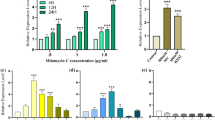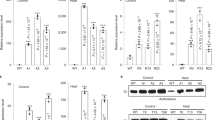Abstract
Oenothera plants homozygous for the recessive plastome mutator allele (pm) show chloroplast DNA (cpDNA) mutation frequencies that are about 1,000-fold higher than spontaneous levels. The pm-encoded gene product has been hypothesized to have a function in cpDNA replication, repair and/or mutation avoidance. Previous chemical mutagenesis experiments with the alkylating agent nitroso-methyl urea (NMU) showed a synergistic effect of NMU on the induction of mutations in the pm line, suggesting an interaction between the pm-encoded gene product and one of the repair systems that corrects alkylation damage. The goal of the experiments described here was to examine whether the pm activity extends to the repair of damage caused by non-alkylating mutagens. To this end, the intercalating mutagen, 9-aminoacridine hydrochloride (9AA) was tested for synergism with the plastome mutator. A statistical analysis of the data reported here indicates that the pm-encoded gene product is not involved in the repair of the 9AA-induced mutations. However, the recovery of chlorotic sectors in plants derived from the mutagenized seeds shows that 9AA can act as a mutagen of the chloroplast genome.



Similar content being viewed by others
References
Blasko K, Kaplan SA, Higgins KG, Wolfson R, Sears BB (1988) Variation in copy number of a 24-base pair tandem repeat in the chloroplast DNA of Oenothera hookeri strain Johansen. Curr Genet 14:287–292
Brennicke A, Schwemmle B (1984) Inheritance of mitochondrial DNA in Oenothera berteriana and Oenothera odorata hybrids. Z Naturforsch 39:191–192
Chang TL, Stoike LL, Zarka D, Schewe G, Chiu WL, Jarrell DC, Sears BB (1996) Characterization of primary lesions caused by the plastome mutator of Oenothera. Curr Genet 30:522–530
Chiu WL, Stubbe W, Sears BB (1988) Plastid inheritance in Oenothera: organelle genome modifies the extent of biparental plastid transmission. Curr Genet 13:181–189
Chiu WL, Johnson EM, Kaplan SA, Blasko K, Sokalski MB, Wolfson R, Sears BB (1990) Oenothera chloroplast DNA polymorphisms associated with plastome mutator activity. Mol Gen Genet 221:59–64
D'Amato F (1950) Mutazioni clorofilliane nell'oro indotte da derivati acridinici. Caryologia 3:211–220
D'Amato F (1952) Mutagenic activity of acridines. Caryologia 4:388–413
Doyle JJ, Doyle JL (1987) A rapid DNA isolation procedure for small quantities of fresh leaf tissue. Phytochem Bull 19:11–15
Epp MD (1973) Nuclear gene-induced plastome mutations in Oenothera hookeri I. Genetic analysis. Genetics 75:465–483
Gordon A, Halliday J, Horsfad M, Glickman B (1991) Spontaneous and 9-aminoacridine-induced frameshift mutagenesis: second site frameshift mutation within the N-terminal region of the lacI gene of Escherichia coli. Mol Gen Genet 227:160–164
Gu J, Miles D, Newton KJ (1993) Analysis of leaf sectors in the NCS6 mitochondrial mutant of maize. Plant Cell 8:963–971
Hagemann R (1982) Induction of plastome mutations by nitroso-urea compounds. In: Edelman M, Hallick RB, Chua N-H (eds) Methods in chloroplast Molecular Biology. Elsevier, Amsterdam, pp 119–127
Hoffman GR, Freemer CS, Parente LA (1989) Induction of genetic duplications and frameshift mutations in Salmonella typhimurium by acridines and acridine mustards: dependence on covalent binding of the mutagen to DNA. Mol Gen Genet 218:377–383
Hunt MD, Newton KJ (1991) The NCS3 mutation: genetic evidence for the expression of ribosomal protein genes in Zea mays mitochondria. EMBO J 5:1045–1052
Kopsidas G, MacPhee DG (1994) Mutagenesis by 9-aminoacridine in Salmonella typhimurium: inhibition by glucose and other PTS class A carbon sources. Mutat Res 306:111–117
Kutzelnigg H, Stubbe W (1974) Investigations on plastome mutants in Oenothera 1. General considerations. Sub Cell Biochem 3:73–89
Miller JH (1998) Mutators in Escherichia coli. Mutat Res 409:99–106
Nasim A, Brychcy T (1979) Genetic effects of acridine compounds. Mutat Res 65:261–288
Rether B, Delmas G, Laouedj A (1993) Isolation of polysaccharide-free DNA from plants. Plant Mol Biol Rep 11:333–337
Sambrook J, Fritsch EF, Maniatis T (1989) Molecular cloning, a laboratory manual, 2nd edn. Cold Spring Harbor Laboratory, Cold Spring Harbor, New York
Sears BB, Sokalski MB (1991) The Oenothera plastome mutator: effect of UV irradiation and nitroso-methyl urea on mutation frequencies. Mol Gen Genet 229:245–252
Sears BB, Lim PO, Holland N, Kirkpatrick BC, Klomparens KL (1989) Isolation and characterization of DNA from a mycoplasma-like organism. Mol Plant Microbe Interact 4:175–180
Skopek TR, Hutchinson F (1984) Frameshift mutagenesis of lambda prophage by 9-aminoacridine, proflavin and ICR-191. Mol Gen Genet 195:418–423
Stoike LL, Sears BB (1998) Plastome mutator-induced alterations arise in Oenothera chloroplast DNA through template slippage. Genetics 149:347–353
Stubbe W, Herrmann RG (1982) Selection and maintenance of plastome mutants and interspecific genome/plastome hybrids from Oenothera. In: Edelman M, Hallick RB, Chua NH (eds) Methods in chloroplast molecular biology. Elsevier, Amsterdam, pp 149–165
Thomas SM, MacPhee DG (1985) Frameshift mutagenesis by 9-aminoacridine and ICR191 in Escherichia coli: effects of uvrB, recA, and lexA mutations in plasmid pKM101. Mutat Res 151:49–56
Acknowledgements
We thank Christine Chase for the mtDNA clone, David Jarrell for advice on DNA extraction, and Elaine Palucki for critical comments on the manuscript. We gratefully acknowledge funding from the Michigan Agricultural Experiment Station and the National Science Foundation (DCB 8502849, MCB 9019488 and MCB 9982600 to BBS).
Author information
Authors and Affiliations
Corresponding author
Additional information
Communicated by R. Hagemann
Rights and permissions
About this article
Cite this article
GuhaMajumdar, M., Baldwin, S. & Sears, B.B. Chloroplast mutations induced by 9-aminoacridine hydrochloride are independent of the plastome mutator in Oenothera . Theor Appl Genet 108, 543–549 (2004). https://doi.org/10.1007/s00122-003-1454-2
Received:
Accepted:
Published:
Issue Date:
DOI: https://doi.org/10.1007/s00122-003-1454-2




